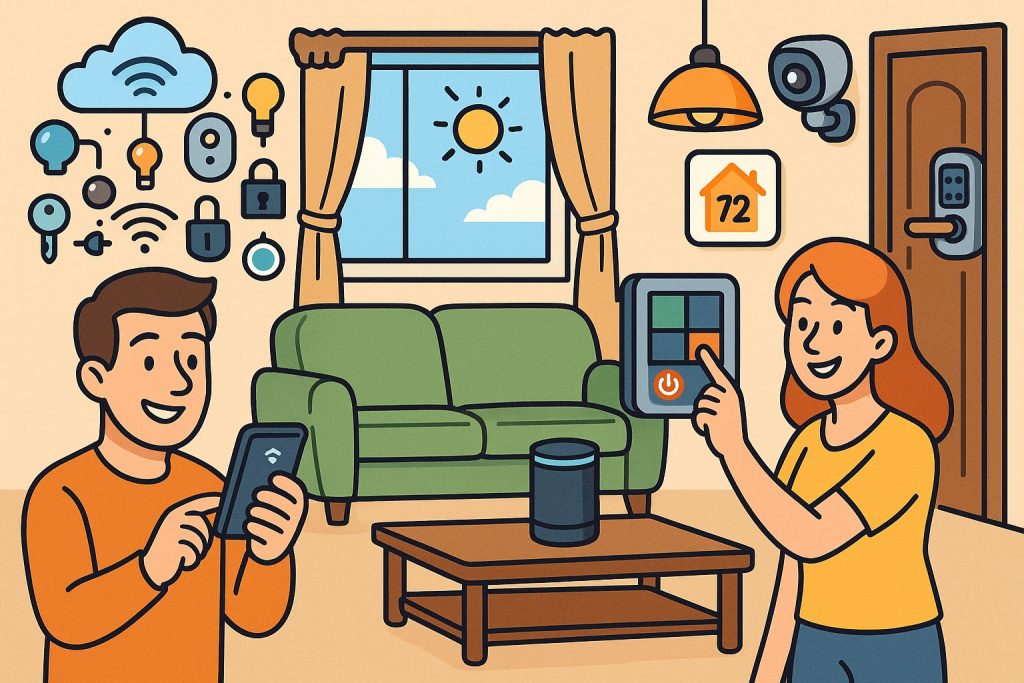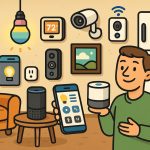A smart home is more than just a collection of modern gadgets — it’s an integrated environment where devices communicate, automate tasks, and enhance comfort, safety, and energy efficiency. With the rise of the Internet of Things (IoT) and voice assistants, smart homes are reshaping how we interact with the spaces we live in.
Key Features of a Smart Home
A smart home uses connected devices that can be controlled remotely or operate autonomously based on preset conditions or learned behavior. These systems can include:
- Smart lighting: Lights that turn on/off or dim automatically based on presence, time of day, or user commands.
- Smart thermostats: Devices that learn your habits and adjust temperature for comfort and energy savings.
- Smart locks and security cameras: Remote access and real-time monitoring to enhance home security.
- Voice assistants: AI-powered systems like Alexa, Siri, or Google Assistant that manage tasks through spoken commands.
- Smart appliances: Refrigerators, ovens, washing machines, and more that can be controlled or scheduled via mobile apps.
How It Works
At the core of every smart home is a wireless network that connects all smart devices. These may operate through:
- Wi-Fi: For high-bandwidth needs like video streaming.
- Bluetooth/Zigbee/Z-Wave: For low-power communication between devices.
- Cloud services: Many smart homes rely on cloud platforms to process data and enable remote access via smartphones.
Devices are often managed through a central hub or app, allowing homeowners to monitor and control systems in real time, whether they’re at home or away.
Benefits of a Smart Home
- Convenience
Automate routines like turning off lights when leaving or starting the coffee maker at a specific time. - Energy Efficiency
Smart thermostats and lights help reduce electricity use by adapting to real-time needs. - Security
Motion sensors, smart locks, and cameras provide instant alerts and can be managed remotely. - Accessibility
Voice commands and automation help elderly or disabled individuals control home environments more easily. - Cost Savings
Efficient energy use and water management (like smart irrigation systems) can lower monthly utility bills.
Challenges and Considerations
Despite their advantages, smart homes present certain challenges:
- Privacy concerns: Devices collect and transmit data that could be vulnerable to misuse.
- Cybersecurity risks: Without proper protection, smart homes can be hacked.
- Compatibility issues: Not all devices work together seamlessly across platforms.
- Dependence on internet: Many smart features rely on constant connectivity.
To address these risks, users should use strong passwords, enable software updates, and choose reputable brands that prioritize security.
The Future of Smart Homes
The future points toward greater automation, AI integration, and inter-device communication. We can expect smart homes to:
- Learn behavior patterns for proactive adjustments.
- Integrate with electric vehicles and renewable energy systems.
- Use edge computing for faster local decision-making without cloud delays.
- Support sustainable living through better resource management.
Conclusion
A smart home transforms daily life by connecting devices into an intelligent network that anticipates needs, improves security, and simplifies tasks. While some risks and challenges remain, with proper setup and awareness, smart homes offer a glimpse into a more efficient, responsive, and comfortable future.
Glossary
- Smart Home – A residence equipped with devices that automate and remotely control systems like lighting, heating, and security.
- Internet of Things (IoT) – A network of physical devices embedded with sensors and software to communicate over the internet.
- Automation – The ability for systems to perform tasks without human input, based on rules or learned behavior.
- Edge Computing – Processing data locally on devices instead of relying on centralized cloud servers.
- Voice Assistant – AI software that responds to spoken commands to perform tasks like playing music or controlling lights.


